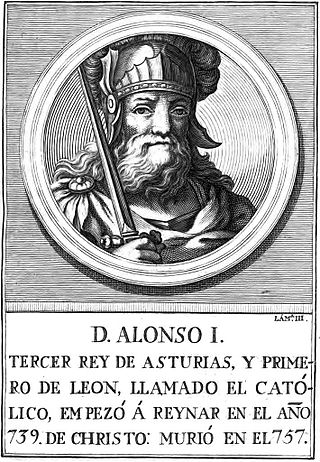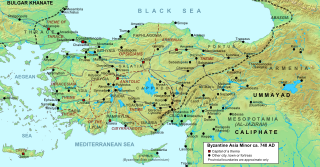
The 8th century is the period from 701 through 800 (DCCC) in accordance with the Julian Calendar.
The 740s decade ran from January 1, 740, to December 31, 749.
The 710s decade ran from January 1, 710, to December 31, 719.
The 700s decade ran from January 1, 700, to December 31, 709.

Year 741 (DCCXLI) was a common year starting on Sunday of the Julian calendar. The denomination 741 for this year has been used since the early medieval period, when the Anno Domini calendar era became the prevalent method in Europe for naming years.

Year 740 (DCCXL) was a leap year starting on Friday of the Julian calendar, the 740th year of the Common Era (CE) and Anno Domini (AD) designations, the 740th year of the 1st millennium, the 40th year of the 8th century, and the 1st year of the 740s decade. The denomination 740 for this year has been used since the early medieval period, when the Anno Domini calendar era became the prevalent method in Europe for naming years.

Year 724 (DCCXXIV) was a leap year starting on Saturday of the Julian calendar, the 724th year of the Common Era (CE) and Anno Domini (AD)
Hisham ibn Abd al-Malik ibn Marwan was the tenth Umayyad caliph, ruling from 724 until his death in 743.

Al-Walid ibn Yazid ibn Abd al-Malik, commonly known as al-Walid II, was the eleventh Umayyad caliph, ruling from 743 until his assassination in 744. He succeeded his uncle, Hisham ibn Abd al-Malik.
Maslama ibn Abd al-Malik was an Umayyad prince and one of the most prominent Arab generals of the early decades of the 8th century, leading several campaigns against the Byzantine Empire and the Khazar Khaganate. He achieved great fame especially for leading the second and last Arab siege of the Byzantine capital Constantinople.

The Battle of Akroinon was fought at Akroinon or Akroinos in Phrygia, on the western edge of the Anatolian plateau, in 740 between an Umayyad Arab army and the Byzantine forces. The Arabs had been conducting regular raids into Anatolia for the past century, and the 740 expedition was the largest in recent decades, consisting of three separate divisions. One division, 20,000 strong under Abdallah al-Battal and al-Malik ibn Shu'aib, was confronted at Akroinon by the Byzantines under the command of Emperor Leo III the Isaurian and his son, the future Constantine V. The battle resulted in a decisive Byzantine victory. Coupled with the Umayyad Caliphate's troubles on other fronts and the internal instability before and after the Abbasid Revolt, this put an end to major Arab incursions into Anatolia for three decades.

The Byzantine Empire was ruled by the Isaurian dynasty from 717 to 802. The Isaurian emperors were successful in defending and consolidating the empire against the caliphates after the onslaught of the early Muslim conquests, but were less successful in Europe, where they suffered setbacks against the Bulgars, had to give up the Exarchate of Ravenna, and lost influence over Italy and the papacy to the growing power of the Franks.

The siege of Nicaea of 727 was an unsuccessful attempt by the Umayyad Caliphate to capture the Byzantine city of Nicaea, the capital of the Opsician Theme. Ever since its failure to capture the Byzantine Empire's capital, Constantinople, in 717–718, the Caliphate had launched a series of raids into Byzantine Asia Minor. In 727, the Arab army, led by one of the Caliph's sons, penetrated deep into Asia Minor, sacked two Byzantine fortresses and in late July arrived before Nicaea. Despite constant attacks for 40 days, the city held firm and the Arabs withdrew and returned to the Caliphate. The successful repulsion of the attack was a major boost for Byzantine emperor Leo III the Isaurian's recently initiated campaign to abolish the veneration of icons in the Empire; Leo claimed it as evidence of divine favour for his policy. The siege of Nicaea marks also the high point of the Umayyad raids, as new threats and defeats on their far-flung frontiers decreased Umayyad strength elsewhere, while Byzantine power strengthened afterwards.
Mu'awiya ibn Hisham (Arabic: معاوية بن هشام, romanized: Muʿāwiya ibn Hishām; was an Arab general and prince, the son of the Umayyad Caliph Hisham ibn Abd al-Malik, who distinguished himself in the Arab–Byzantine Wars. His son, Abd al-Rahman ibn Mu'awiya, was the founder of the Emirate of Córdoba and the Umayyad line of al-Andalus.
Sulaymān ibn Hishām ibn ʿAbd al-Malik was an Arab general, the son of the Umayyad Caliph Hisham ibn Abd al-Malik. He is known for his participation in the expeditions against the Byzantine Empire as well as his prominent role in the civil wars that occurred during the last years of the Umayyad Caliphate. Defeated by Marwan II, he fled to India, where he died.
al-ʿAbbās ibn al-Walīd ibn ʿAbd al-Malik was an Umayyad prince and general, the eldest son of Caliph al-Walid I. He distinguished himself as a military leader in the Byzantine–Arab Wars of the early 8th century, especially in the Siege of Tyana in 707–708, and was often a partner of his uncle Maslama ibn Abd al-Malik during these campaigns. He or his father are credited for founding the short-lived city of Anjar in modern Lebanon.
Umar ibn Hubayra al-Fazari was a prominent Umayyad general and governor of Iraq, who played an important role in the Qays–Yaman conflict of this period.
Khālid ibn ʿAbdallāh al-Qasrī was an Arab who served the Umayyad Caliphate as governor of Mecca in the 8th century and of Iraq from 724 until 738. The latter post, entailing as it did control over the entire eastern Caliphate, made him one of the most important officials during the crucial reign of Caliph Hisham ibn Abd al-Malik. He is most notable for his support of the Yaman tribes in the conflict with the Qays who dominated the administration of Iraq and the East under his predecessor and successor. Following his dismissal, he was twice imprisoned and in 734 tortured to death by his successor, Yusuf ibn Umar al-Thaqafi.
Maslama ibn Hisham ibn Abd al-Malik, also known by his kunyaAbu Shakir, was an Umayyad prince and commander.







